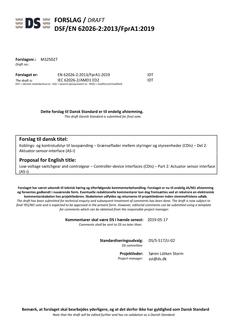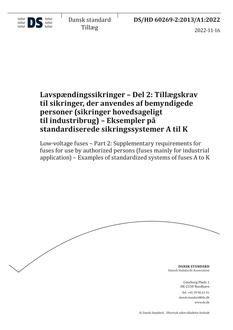-
-
Available Formats
- Availability
- Priced From ( in USD )
-
Available Formats
-
- Immediate download
- $77.00
- Add to Cart
-
- Printed Edition
- Ships in 1-2 business days
- $77.00
- Add to Cart
Customers Who Bought This Also Bought
-

DANSK DSF/EN 62026-2/FPRA1
Priced From $35.00 -

DANSK DS/ISO/IEC TS 23167
Priced From $110.00 -

DANSK DS/HD 60269-2
Priced From $202.00 -

DANSK DS/EN 1756-1
Priced From $110.00
About This Item
Full Description
1.1 This International Standard aims at providing general utilization guidelines and calculation methods adequate to guarantee the effectiveness and ultimate load strength of tie-down / lashing arrangements performed to restrain cargo on board civil transport aircraft during flight : a) cargo loaded and tied down onto airworthiness approved air cargo pallets, themselves restrained into aircraft lower deck or main deck or upper deck cargo systems meeting the restraint requirements of air cargo pallets approved in accordance with ISO 8097 (NAS3610) or ISO 21100, or b) additional tie-down on aircraft structure when necessitated by pallet maximum gross mass or center of gravity limits, or c) non unitized individual pieces of cargo, or pieces of cargo placed onto an unrestrained (“floating”) pallet into either lower deck, main deck or upper deck containerized cargo compartments of an aircraft, or d) individual pieces of load loaded in non containerized (bulk loaded) baggage or cargo compartments. 1.2 This International Standard applies to cargo tie-down / lashing arrangements using exclusively air cargo restraint straps conforming to International Standard ISO 16049-1, Air cargo equipment – Restraint straps – Part 1 : Design criteria and testing methods. Its general recommendations may also be used for tie-down arrangements using other means (e.g. steel cables, rope, other types of straps), but under the user’s responsibility as to their adequacy and the strength calculations required. NOTE 1 – Where tie-down is performed onto aircraft structure as per clauses 1.1 (b) or (c) above, additional restrictions may be stated in the aircraft's Authority approved Weight and Balance Manual, and shall be complied with. NOTE 2 – The use of chains or other rigid devices for tie-down onto civil transport aircraft floor tracks is not part of the scope of this International Standard, since not recommended due to the possibility of generating excessive stresses in the aircraft structure, except where explicitly approved in the manufacturer's Authority approved Weight and Balance Manual. NOTE 3 – Where tie-down is performed onto aircraft structure as per 1.1.1 (b) or (c) above, additional restrictions may be stated in the aircraft's Authority approved Weight and Balance Manual, and shall be complied with. 1.3 This International Standard aims at providing industry recognized means of complying with Airworthiness Authorities general regulations applicable to load securing on board civil transport aircraft (see 14 CFR Part 25 and EASA CS-25), and aircraft manufacturers Authority approved Weight and Balance Manuals for each aircraft type as specified therein. It is not the intent of this International Standard to specify when restraint straps should be used, but how they should be used. It does not, under any circumstance, supersede the requirements of any of the above documents, that take precedence at all times.
Document History
-
DANSK DS/ISO 16049-2
Air cargo equipment – Restraint straps – Part 2: Utilization requirements and recommendations and lashing calculations- Most Recent
-
DANSK DS/ISO 16049-2
currently
viewing
Air cargo equipment – Restraint straps – Part 2: Utilization guidelines and lashing calculations- Historical Version





